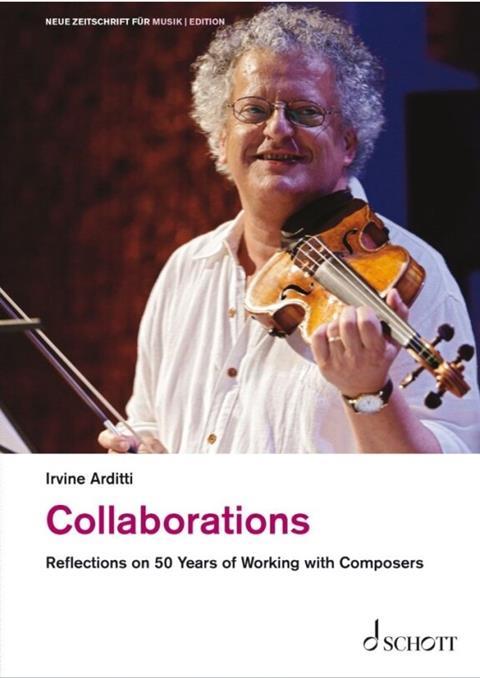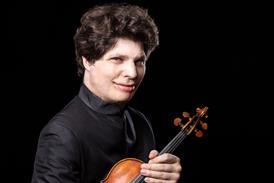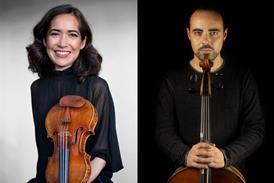Pwyll ap Siôn reads the memoirs of Irvine Arditti, new music specialist and founder of the eponymous quartet

Collaborations: Reflections on 50 Years of Working with Composers
Irvine Arditti
520PP ISBN 9783795726126
Schott Music £34
Known for having commissioned, performed, and recorded some of the most challenging music for strings during the late 20th and early 21st centuries, Irvine Arditti has never done things by half measures.
This is also the case with his new book, Collaborations. At over five hundred pages long and densely packed with interpretative insights, analysis, reflections, quotes and anecdotes, Collaborations is part autobiography, part compendium of extended string techniques, part instructional textbook on contemporary performance practice methods and partly a historical overview of the post-1945 avant-garde movement.
However, as its title suggests, Collaborations is mainly about the nature of human relationships in the act of music making. This point is emphasised by Arditti throughout. Having performed over a thousand works as soloist and leader of his eponymous quartet, Arditti and the Ardittis have benefited from the direct contact with the composers themselves.
These have varied from occasionally tetchy and difficult affairs (Kagel, Berio) to positive relationships that developed into lifelong friendships (Harvey, Rihm, Dillon). Arditti describes how some composers could be ‘hands-off’ in rehearsal, noting that working with the enigmatic Giacinto Scelsi was ‘like being involved in a religious ceremony’. For composers like György Kurtag, the process was far more ‘hands on’, with rehearsals going on for hours on end.
Some composers would submit scores for newly commissioned works with days or weeks to spare, while the final pages from others would hastily arrive on the morning of the premiere, the ink still wet on the page. Most importantly, all these experiences influenced the final outcome, both in terms of the composer’s own input into the collaborative process and Arditti’s ability to harness often supremely difficult physical, technical, aesthetic and philosophical challenges associated with performing these works into richly rewarding artistic results.
Given the nature of the music in question, it perhaps comes as no surprise to readers that passages detailing intricate mathematical time calculations are sometimes difficult to follow, such as when summarising Brian Ferneyhough’s Dum Transisset II: ‘we must think of the bar in four with a faster tempo, 93/3.5 x 4 = 106.285714’. (Most musicians’ metronomes do not extend to quite that number of decimal points.)
Nevertheless, Arditti presents this repertoire for the most part in a surprisingly direct, accessible and readable style. As light relief from the passages containing dense analytical prose, some amusing stories are also recounted, such as the violinist sharing a sauna with Xenakis, Henze answering his door in a dressing gown, Nono adding salt to his tea in a London café instead of sugar (and then continuing to drink it), Ferneyhough insisting that the quartet should rehearse the silences between the movements in his String Quartet no.3, Rihm’s ‘phobia’ for avoiding metronome markings, and Arditti’s violin almost being confiscated by the Communist authorities at Moscow airport in 1995.
For string players, the main takeout in the book may well be Arditti’s often exhaustive explanations of what may be called ‘extended string techniques.’ These include fingernail pizzicatos, battuto, frappe col legno (a fast battuto with the wood of the bow), ricochet, jeté, spiccatos, balzato-type gestures, tabla (hitting the body of the instrument with the palm or the fingers), particular types of bridge sounds, flautando molto tasto, gettatini (a continuous gettato bow), spazzolare (‘a fast windshield-wiper movement of the bow on the fingerboard between the tasto and sul ponticello areas’), in addition to various types of glissando, microtonality, irrational rhythmic patterns, poly-temporality and so on.
It’s all described in meticulous detail, alongside several scans from scores, with some of them usefully containing Arditti’s own pencil annotations. Aspiring string players aspiring to explore this repertoire would do well to read the violinist’s own detailed and illuminating performance instructions before rehearsing a note of the music.
As with any memoir, there is a sense in which Arditti’s narrative reads like a snapshot of what now feels like a bygone era, where white male composers dominated the world of contemporary music, and artistic merit was judged according to criteria based on complexity, virtuosity, cleverness, sophistication and abstraction.
Read: Life Lessons: Irvine Arditti
Read: Arditti Quartet founding member Levine Andrade has died
Read: Irvine Arditti’s sentimental work: Helmut Lachenmann’s Grido
Some will no doubt note the glaring absence of gender and racial diversity within these pages. Of the 25 composers featured in each chapter, 21 of those are white male Europeans/Americans (by my reckoning, at least), while the only female composer represented in the entire collection is the violinist’s wife, Hilda Paredes.
Arditti is careful not to wade too much into broader ideological issues concerning cultural, racial and gender-based ramifications associated with this repertoire, some of which have been addressed by other performers of the so-called ‘new complexity’ movement, but the absence of female composers such as Liza Lim, Alwynne Pritchard, Chaya Czernowin and Rebecca Saunders will be viewed as a disappointing omission by some, especially since the Arditti Quartet has performed and recorded music by three of these composers.
Nevertheless, Collaborations is without doubt a valuable book for anyone interested in the modern classical music of the past 50 years, providing essential reading for string players specialising in avant-garde repertoire, and offering an indispensable companion to Arditti and Robert H.P. Platz’s co-authored book on the techniques of contemporary violin playing, published by Bärenreiter in 2012.
PWYLL AP SIÔN



































No comments yet